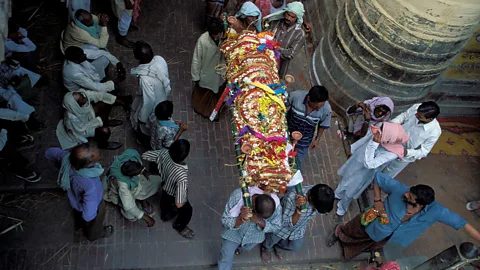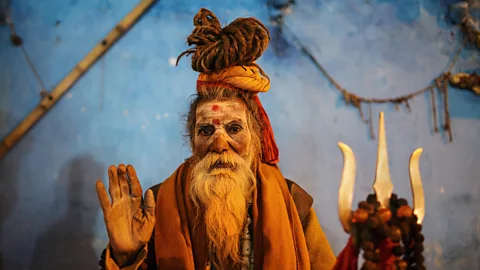Varanasi: India's holy 'City of Death'
 Rajiv Malu EyeEm/Getty Images
Rajiv Malu EyeEm/Getty ImagesHindu pilgrims have long come to Varanasi to die, believing that it will bring salvation. But by wandering aimlessly, Pico Iyer realises this city of death is actually a city of joy.
There were fires, six, seven of them, rising through the winter fog. Groups of men, scarves wrapped around their heads, eyes blazing in the half-light, were gathered, barefoot, around the flames, edging closer. A nearly naked figure with dusty, matted dreadlocks down to his waist was poking at a charred head with a bamboo pole. There was chanting in the distance, a shaking of bells, a furious drumming in the distance, and in the infernal no-light of the New Year dusk, I could make out almost nothing but orange blazes, far off, by the river.
How much of this was I dreaming? How much was I under a "foreign influence", if only of jet lag and displacement? Figures came towards me out of the mist, smeared in ash from head to toe, bearing the three-pronged trident of the holy city's patron, Shiva, "Ender of Time". As I passed into the little alleyways behind the flames, I arrived at a warren of tiny streets, in which a shrunken candle burned in the dark of a bare earth cavern. A boy was seated on the ground, behind a pair of scales. Cows were padding ceaselessly down the clogged, dung-splattered lane. Every now and then, another group of chanters surged past, a dead body under a golden shroud on the bamboo stretcher that they carried towards the river. I pressed myself against a wall, and a whisper of mortality brushed me.
 Dinodia Photo/Getty Images
Dinodia Photo/Getty ImagesI fumbled my way through the pitch-black, in the labyrinth of narrow passageways, and another corpse came by, two women in their finest silk saris sludging barefoot through soft mud towards the holy waters. I followed intuition in and out of the dark streets, past little candles flickering in shrines and openings where men were whispering sacred syllables. Then, turning a corner, I came to an intersection and three men stood before me, guns protruding from behind their backs.
It was strange to think that, just 72 hours earlier, I had been on the far side of the world, marking a quiet New Year's Day in the sun. Now there were goats with auspicious red marks on their foreheads trotting around, and embers burning and oil-lamps drifting across the river in the fog. Along the walls were painted orange faces, laughing monkey gods, sacred looming phalluses. Shops on every side were selling sandalwood paste and clarified butter oil for dead bodies, tiny clay urns for ashes.
The city of death had once been known as "Kashi", or "City of Light". The English writer Richard Lannoy, who all but lost his soul to Varanasi, had called it a "City of Darkness and Dream". In a long and often hallucinatory book, he had quoted the Chief Superintendent of Police of what once was called Benares describing "the abduction of women from temples, prostitution in the name of God, the prevalence of theft on the pilgrim scene, the cannibalistic customs of the Aghoris, the drunken orgies of bogus tantriks".
Yet what startled me most as I began to walk its streets was that the city of extinction was, without question, a city of joy. The people hurrying past me towards the burning pyres, bearing dead bodies towards the sacred river, were raising their voices in praise, and in a great, overwhelming cry of thanks.
 Aman Chotani/Getty Images
Aman Chotani/Getty ImagesUrban India everywhere is an immersion in intensity – shock therapy of a kind – but the holy city inhabits a category all its own. The traffic was converging on every inch of road from every direction, yet, true to its mystic's contempt for reason, the place possessed no traffic lights. Here and there an elderly policeman with a mask over his mouth extended a hopeful arm, as cars, cows, bicycles, trucks heedlessly crashed past him. Dogs were sleeping in the middle of the busy road – Varanasi's Fifth Avenue, I surmised – and men were outstretched (sleeping, I hoped) along the side and on the pavement. A crowd had gathered in the middle of the street around a man who was dervishing around, whirling swords.
I knew the sacred waters had to be my first stop, so I dropped my bags off at a hotel and jumped into a car to head towards the ghats. In the course of the 20-minute ride, we passed two jubilant corpse processions, two parades of children.
"This is a very inauspicious time," a young local turned round from the front seat to warn me (behind him I could see only a mass of raging, but unadvancing, bodies and vehicles, riding their horns). "It is called Kharmas. Everyone stays hidden in this time; no one talks about weddings, things like that. Everyone is silent. It is like a curse placed on the city."
If this was Varanasi at its most silent, I thought, almost unable to hear him as a train, too, thundered past on a brick bridge above us, I couldn't imagine it on one of its frequent festival days. "The curse lifts on January 14th," my new friend told me. "Then we celebrate." This was not cause for celebration for someone due, as I was, to leave on January 13th.
 Yadid Levy/Alamy
Yadid Levy/AlamyWe got out at a Christian church and joined the crush of bodies pushing towards the holy river. The signs along the road spoke of "The Oldest Centre for Abacus Classes" and "Glorious Ladies Tailors", leaving me to wonder whether the glory lay with the ladies or their stitching. "British School for Languages is now Trounce Education", I read on another, offering a droll summary of the end of Empire. In Varanasi, half a million people are squeezed into the one-square-mile darkness of alleyways known as the Old City, with the result that some foreign visitors more or less give out, while others wonder if they've been slipped a tab of some foreign substance.
"Everything is always changing here," announced my guide as we arrived at the riverbank, where holy men were seated under coloured umbrellas on the ground, chanting and smearing paste and ash on foreheads. "Different colours. Different spirit. Different energy. You have to be on high alert when you come to my city."
That much I'd gathered already.
We started walking along the river, dodging refuse and excrement on every side, and passed an almost naked man, staring at us, sheltered by a small fire inside a hut.
 Maciej Dakowicz/Alamy
Maciej Dakowicz/Alamy"He's meditating?" I tried.
"Everything for him is ashes," came the reply. "For these sadhus, they like very much to live with cremation. They don't wear clothes as we do. They don't do anything like people who are living in the material world. They want to live in a world of ash."
A little farther down, we almost walked into a man in a bright blue tunic and turban who was offering what seemed to be bon mots, as at a regular neighbourhood barbershop (though here in Varanasi, the neighbourhood barbershop, like the graveyard, the church and the zoo, was out on the street, and open to all). "Laughing Yogi," my guide explained, and broke into guffaws himself, as if abruptly propelled towards a sudden enlightenment.
A huge, bloated cow floated slowly past. We clambered unsteadily into a small rocking boat, as, on shore, a handful of handsome young boys in elaborate gold pantaloons held up five-armed oil-lamps and began practicing the purgation by fire they'd ritually perform that night. Other vessels were carrying pilgrims off to the dim other shore, a long, empty sandbank, so far as I could tell. Fires were blazing to north and to south, and the air was thick with the smell of marigolds and coal fires.
 Graham Prentice/Alamy
Graham Prentice/Alamy"Only this city, sir, you see 24-hour cremation," offered the boatman, as if speaking of a convenience store. In other cities, cremation grounds are traditionally placed outside the city gates, to the south. Here, they burn at the centre of all life.
I went back to my hotel to take this all in. "Everything is in flux," my young Virgil had told me as we walked along the river. "Everything is a constant succession of becomings. Nothing remains the same."
Pico Iyer is the author of many books on travel. This story was adapted from his most recent book, The Half Known Life, available in the US and Canada and in the UK and elsewhere.
Join more than three million BBC Travel fans by liking us on Facebook, or follow us on Twitter and Instagram.
If you liked this story, sign up for the weekly bbc.com features newsletter called "The Essential List". A handpicked selection of stories from BBC Future, Culture, Capital and Travel, delivered to your inbox every Friday.
